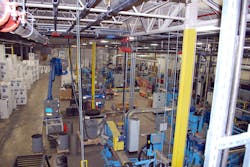Reshoring Sparks Growth in Manufacturing Sector
Declining demand forced manufacturing plants to shelve expansion plans in 2009. Both the recession and the resulting aftermath were to blame for this sharp drop in construction projects and drastic slowdown in spending, says Bernard Markstein, U.S. chief economist for Reed Construction.
“The business fell dramatically, and due to financial problems, they were underutilizing their existing plants,” he says. “They finished up whatever projects they already had underway, but they weren’t about to build anything new.”
Over the last two years, however, the manufacturing sector has begun to regain its strength. After plunging to 36 million sq ft in 2009, the square footage of starts increased to 53 million sq ft in 2011. The dollar value of manufacturing starts also increased 81% in 2011 due to several large projects, such as a $1.5-billion Intel semiconductor plant in Arizona, a $900-million semiconductor plant in Oregon, and a $580-million specialty metals rolling mill in Pennsylvania.
“By 2011, demand was picking up, and there was a lot of delayed investment,” Markstein says. “There were a few years that nothing was done, and manufacturing plants felt the need to invest in new equipment that was more efficient.”
The gypsum industry brought a lot of plants online during the recession to finish up projects, and as a result, it had a lot of excess capacity going into 2011. Manufacturing plants supplying equipment and parts to the energy industry, however, have benefited considerably from the recent boom in natural gas drilling, Markstein says. Automobile manufacturers have also expanded and invested in new equipment. For example, in 2012, a $20-million Rolls Royce manufacturing plant in Indianapolis was under construction, along with a $247-million food processing plant in Batavia, N.Y.
The automotive, food processing, and energy markets have provided an influx of new industrial projects for Feyen Zylstra, an electrical contracting firm based in Grand Rapids, Mich.
“I don’t know if it’s back to pre-recession levels, but it’s certainly come back,” says COO Nate Koetje. “We’ve seen a lot of in-plant facility work with new machines being added and opportunities to work across the country. The comeback of the automotive market has had a positive impact on everyone in the manufacturing industry, and everyone feels more confident going forward.”
Manufacturing now constitutes about 60% of Feyen Zylstra’s business. This percentage has grown over the last few years as controls, automation, and in-plant specialty services have picked up work.
“We are returning to our roots,” Koetje says. “As industrial work faded, we looked for other opportunities. Now we have the chance to go back and use the expertise that we established over the years in the manufacturing sector.”
This growth stems from manufacturing plants’ investment in robotics and automation to reduce costs. As a result, the contractor’s clients have had the opportunity to bring offshore manufacturing jobs back to the United States due to the lower cost of energy and the risks associated with a global marketplace, he says.
Markstein concurs, saying the upturn in U.S. manufacturing stems from the decline in the dollar’s value and the increase in labor costs overseas.
“Labor costs in China are going up, and some manufacturers are bringing operations back to the United States,” he says. “That way, they know what their labor costs will be, and they can have access to reliable suppliers, lower energy prices, and better quality control.”
This is especially true in the high-technology industry, where product cycles are short. By keeping the suppliers close by, American manufacturers don’t need to retain a lot of inventory and can upgrade technology very rapidly, which is helpful for the producers and the consumers.
For 2013, Markstein expects that the industry will have a 6.5% increase due to a mixed bag of both large and small projects. One key factor holding back growth early this year is concern over the federal budget and the debt ceiling.
“It is causing a lot of companies to hold back on their investment and their hiring,” Markstein says. “I’m more positive about the second half of this year and next year, when the economy will perform better, the issues will be resolved, and some of this pent-up demand for investment will proceed. Overall, it will be a good year.”
Fischbach is a freelance writer and editor in Overland Park, Kan. She can be reached at [email protected].


